Sensing Computers and Telepresence
The program - in a new wave of information
technology - is based on Hungarian, multi-disciplinary research results
successful and significant internationally. The program aims at establishing
the basis of new products and services generally important for the society. It
is defined to be on the new frontiers of electronics, computer science and
telecommunication, partially in the field of artificial and biological
information processing.
The
scientific and technological fundamentals of the program are analogical
spatio-temporal sensory computers (a revolutionarily new computer concept),
programmable sensor arrays sensing in different modalities (visual, tactile,
auditory, olfactory etc.), multi-modal sensing, complex event detection in
visual, auditory and tactile scenes, mobile and combined telecommunication
networks and services, and diagnostics in echocardiology.
One
of the sample application areas is the ultrasound-based heart diagnosis where a
system with on-line 3D reconstruction and real-time 2D morphological and motion
tracking capabilities will be designed. With the envisioned innovations the
planning in heart surgery and also the efficiency of routine heart examinations
will be significantly enhanced.
The
engineering result of the other key area will be a multi-modal sensing computer
that, in different modular configurations, could be used as a system for in-
and outdoor security/surveillance, industrial quality control or biometrics
based recognition combined with telepresence capabilities. Typical products in
these areas could be: blind helper bionic eyeglasses identifying
characteristic objects and movements, and home watcher-tackers with
seeing, sniffing, hearing and mobile communication capabilities.
Members of the consortium: MTA SZTAKI, Jedlik
Laboratory of Péter Pázmány Catholic University, Research Institute for Technical
Physics and Materials Science of HAS, Neurobiology Research Unit at Semmelweis
Medical University, Research Institute of Psychology of HAS, Saint Francis
Hospital, György Gottsegen Hungarian Institute of Cardiology, Center for
Pediatric Cardology, AnaLogic Computers Ltd., IT Consult Pro Inc., GE Medicor
Inc. The project co-ordinator is Dr. Csaba Rekeczky (MTA SZTAKI).
